Generative AI, a revolutionary force in the world of technology, is not merely a fleeting trend but a cornerstone of future technological progress. This article delves into a plethora of statistics that shed light on the increasing influence, adoption rates, and potential global impact of Generative AI.
The Pervasiveness of Generative AI
Generative AI is rapidly transforming various industries, from the creation of immersive virtual worlds to drug compound development and automated content creation. At its core, Generative AI is designed to produce data resembling the data it has been trained on.
This comprehensive overview delves into the latest Generative AI statistics, offering insights into its current applications, future potential, and the challenges it faces. Let’s explore how Generative AI is shaping the future of technology and business.
Generative AI Adoption Across Industries
The adoption of Generative AI is on the rise, significantly impacting various sectors. Here are some key statistics regarding its adoption rates:
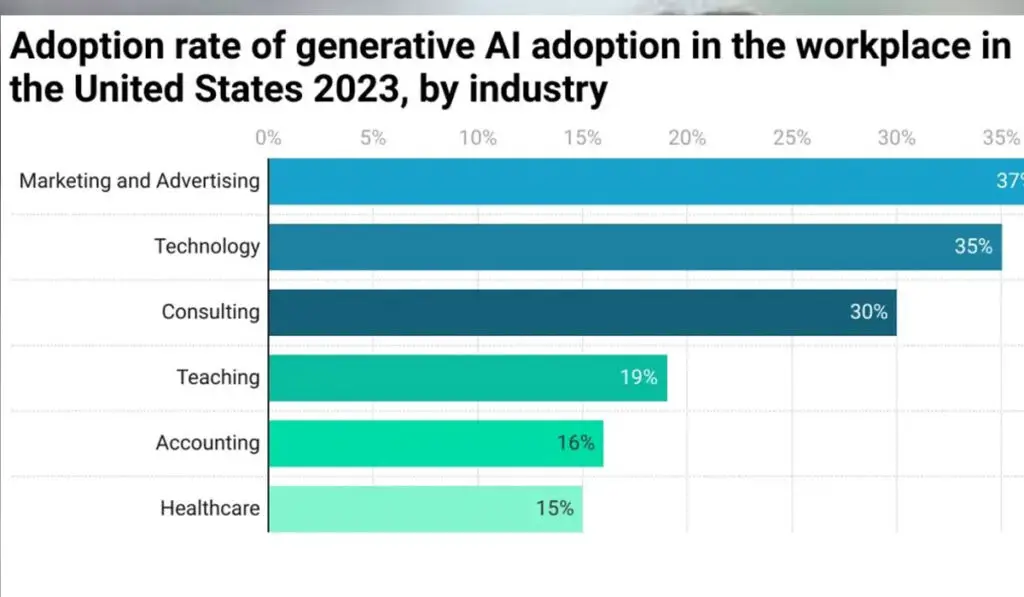
Technology and Consulting Sectors
- The Technology industry leads the pack with an impressive adoption rate of 35%.
- Consulting closely follows with a 30% adoption rate.
- Tools like ChatGPT and DALI have streamlined processes and improved service offerings in these domains.
Education and Accounting
- The Education sector is catching up, boasting a 19% adoption rate, using Generative AI for personalized learning experiences and curriculum development.
- The meticulous Accounting industry stands at a 16% adoption rate, leveraging Generative AI for predictive analytics and financial forecasting.
Healthcare
- Healthcare, a critical sector, lags slightly behind with a 15% adoption rate, but the potential for transformation is immense, spanning from drug discovery to patient care.
Manufacturing
- McKinsey predicts that by 2027, 30% of manufacturers will integrate Generative AI into their operations, enhancing precision, efficiency, and complex design and prototype creation.
Content Creation and Marketing
- The content creation realm is witnessing a surge in Generative AI adoption, driven by tools like ChatGPT. Marketers and bloggers are optimizing content, with statistics indicating steady growth in utilization.
Economic and Industry Impact of Generative AI
Generative AI is poised to have a profound impact on industries and the global economy:
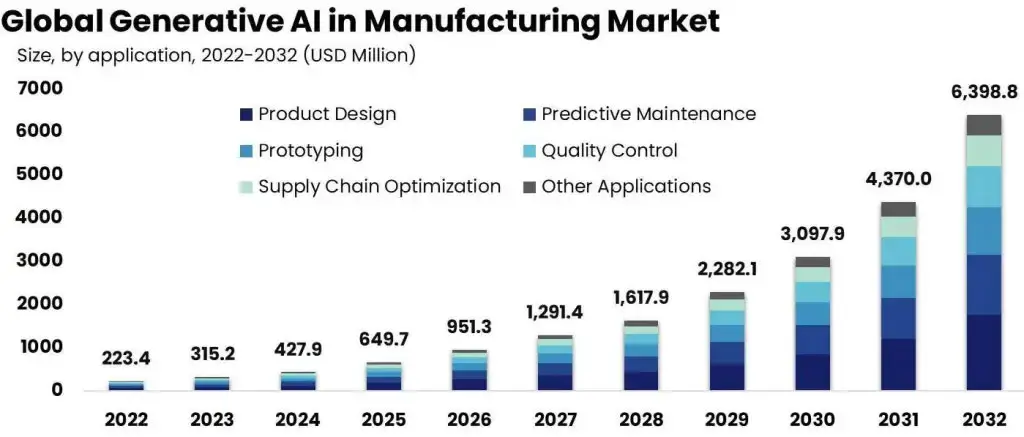
Boost to Global GDP
- Generative AI could potentially increase the global GDP by a remarkable 7%, driven by enhanced efficiencies, the creation of new market segments, and task automation.
Revolutionizing Procedural Code Development
- By 2025, it is expected that 20% of procedural code will be generated by AI, reducing manual coding efforts and accelerating software deployment.
Manufacturing Sector
- Generative AI is projected to be integrated by 30% of manufacturers by 2027, leading to intricate design creation, production line optimization, and significant cost savings.
Pharmaceutical Processes
- Generative AI is expediting drug development, with predictions indicating that by 2025, 50% of new drug compounds could be discovered with the assistance of Generative AI, potentially saving billions and accelerating time-to-market.
Content Creation
- Tools like ChatGPT and DALL-E are reshaping content creation. Marketers, designers, and content creators are using Generative AI to produce high-quality content at scale, resulting in enhanced user engagement and improved ROI.
Financial Sector
- Advanced algorithms are being used in the financial sector for forecasting, risk assessment, and fraud detection, ensuring more informed decision-making and asset safeguarding.
Investment and Growth in Generative AI Market Size
Generative AI has garnered substantial attention from investors and industry leaders:

Market Valuation
- As of recent data, the Generative AI market is valued at an impressive $8.65 billion, reflecting industry confidence in its future applications.
Projected Market Growth
- The trajectory for Generative AI is steep, with projections indicating a market value of $15.7 trillion by 2030, driven by innovation, broader sector adoption, and new AI-driven solutions.
Private Funding Influx
- In 2021, Generative AI initiatives received over $52.9 billion in private funding in the United States alone, underscoring investor faith in its potential returns.
Regional Market Share
- North America contributed 42.10% of the global market share for Generative AI in 2022, thanks to its advanced tech ecosystem and early adoption.
Emerging Players
- Startups and emerging players, along with tech giants, are shaping the Generative AI landscape. Innovations like ChatGPT and DALL-E have garnered substantial investments.
Sector-specific Growth
- Sectors such as content creation, healthcare, and manufacturing are witnessing exponential growth rates in Generative AI adoption, promising a bright future.
Regional Generative AI Adoption Statistics
Generative AI adoption varies by region, reflecting unique technological landscapes and market dynamics:
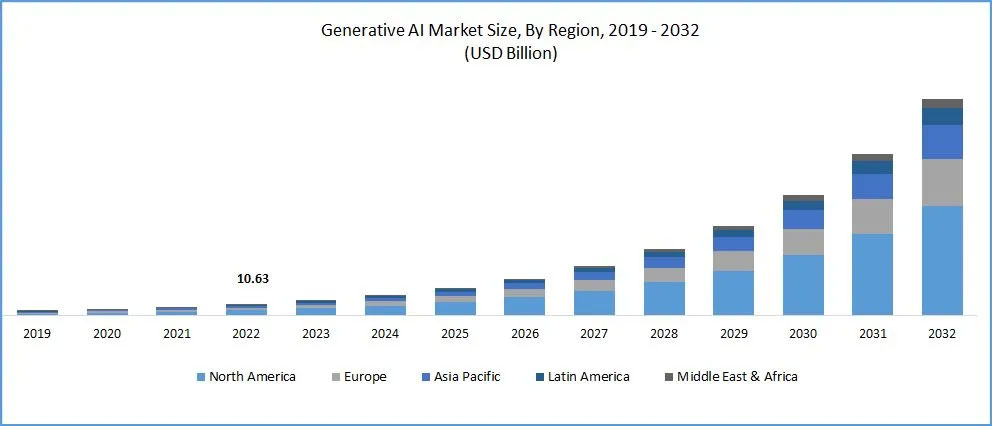
North America
- Contributed 42.10% to the global Generative AI market share in 2022.
- Less than 10% of U.S. residents have utilized Generative AI for social media in 2023.
- Generative AI initiatives in the U.S. received over $52.9 billion in private funding in 2021.
Europe
- European countries, particularly the UK and Germany, have seen a 25% increase in Generative AI startup investments since 2020.
- McKinsey reports that European industries, especially automotive and healthcare, are expected to increase Generative AI integration by 20% by 2025.
Asia-Pacific
- China leads the region with a 30% adoption rate in the manufacturing sector, using Generative AI for design and production optimization.
- Japan and South Korea have reported a 15% increase in Generative AI research grants and projects since 2019.
Latin America
- Brazil witnessed a 10% growth in Generative AI-driven tech startups in 2022.
- Mexico’s education sector is piloting Generative AI tools, with an adoption rate of 8% in 2023.
Africa
- South Africa’s Generative AI market is growing at a CAGR of 12%, with a focus on healthcare and finance.
- Nigeria is exploring Generative AI for agricultural advancements, with pilot projects showing a 5% increase in crop yields.
User Engagement and Perception in Generative AI
Understanding user interactions and perceptions of Generative AI is crucial for its development:
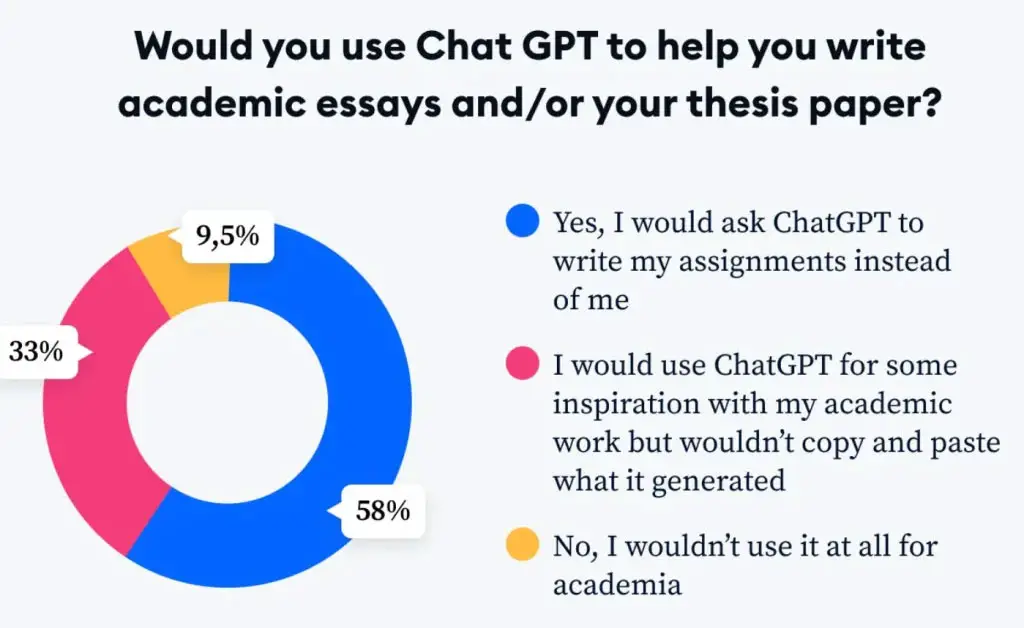
Generative AI Tools Usage
- 29% of Gen Z professionals in the U.S. have used Generative AI tools like ChatGPT and DALL-E in 2023.
- 58.9% of marketers actively use AI tools to optimize content and enhance user engagement.
Preference Over Traditional Methods
- A significant 68% of ChatGPT users prefer the tool over traditional search engines when seeking information, highlighting its efficiency and user-friendly interface.
Reliability Concerns
- 43% of ChatGPT users have reported instances where the tool was inconsistent or unreliable in delivering accurate information.
Ethical and Bias Concerns
- 46% of users have expressed concerns about potential biases in Generative AI responses, emphasizing the need for unbiased training data and refinement.
Future Outlook
- McKinsey’s insights suggest that as Generative AI matures, user trust and engagement levels are expected to rise, leading to broader adoption across demographics.
Challenges and Concerns in Generative AI Adoption
The adoption of Generative AI comes with challenges:
Reliability and Consistency
- Generative AI tools, including ChatGPT, have faced scrutiny regarding their reliability, impacting user trust.
Ethical Implications and Biases
- Concerns about biases and ethical considerations in AI outputs are significant, emphasizing the need for unbiased training data.
Infrastructure and Integration Challenges
- Integrating Generative AI into businesses poses technical challenges, requiring robust infrastructure and skilled personnel.
Economic and Job Displacement Concerns
- While Generative AI increases efficiency, it raises concerns about job displacement and the need for workforce reskilling.
Regulatory and Compliance Issues
- Clear regulatory guidelines are needed to balance responsible use and innovation in Generative AI.
User Privacy and Data Security
- Ensuring ethical data sourcing and secure storage is crucial to maintaining user trust.
Generative AI in Customer Service
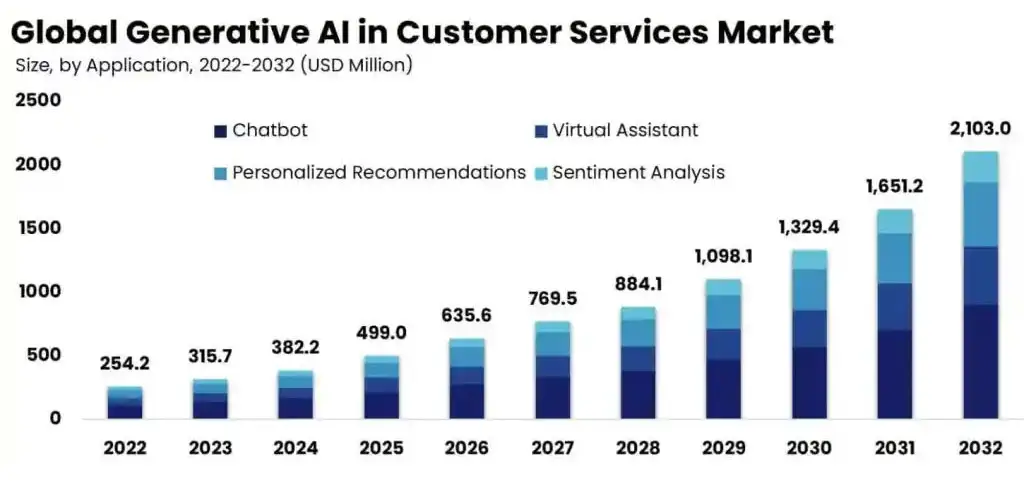
Generative AI is transforming customer service:
- Chatbots powered by Generative AI are becoming integral to customer service, with 67% of consumers believing they will play a crucial role soon.
- Human agents remain essential, with 81% of consumers valuing human interactions alongside AI-driven customer service solutions.
- The chatbot market is growing, projected to reach $1.25 billion by 2025.
- Effective implementation of Generative AI in customer service can lead to a 15% increase in user satisfaction.
- Challenges include instances where AI-driven tools fail to understand user concerns adequately.
Conclusion
Generative AI, as evidenced by these comprehensive statistics, is shaping numerous sectors, from customer service to manufacturing. Its transformative capabilities promise enhanced outputs, innovation, and growth. While challenges exist, the bigger picture is promising. Tools like ChatGPT and DALL-E are just the beginning, showcasing the potential of harnessing artificial intelligence effectively.

